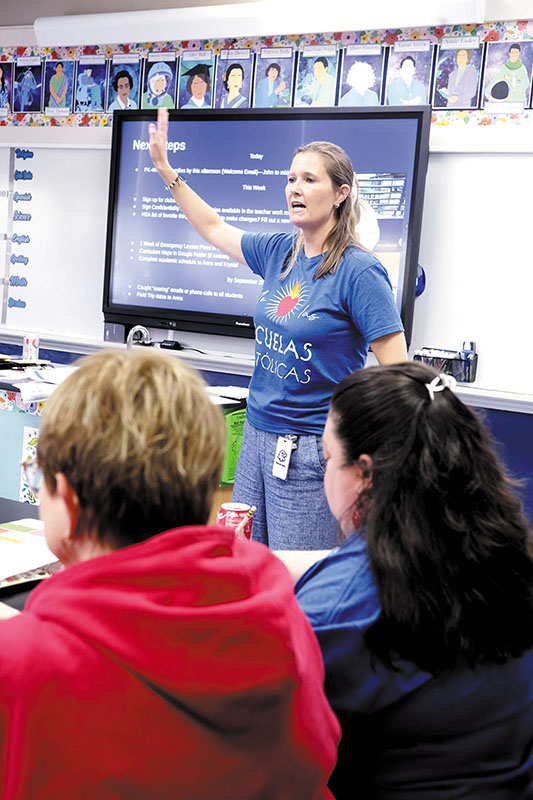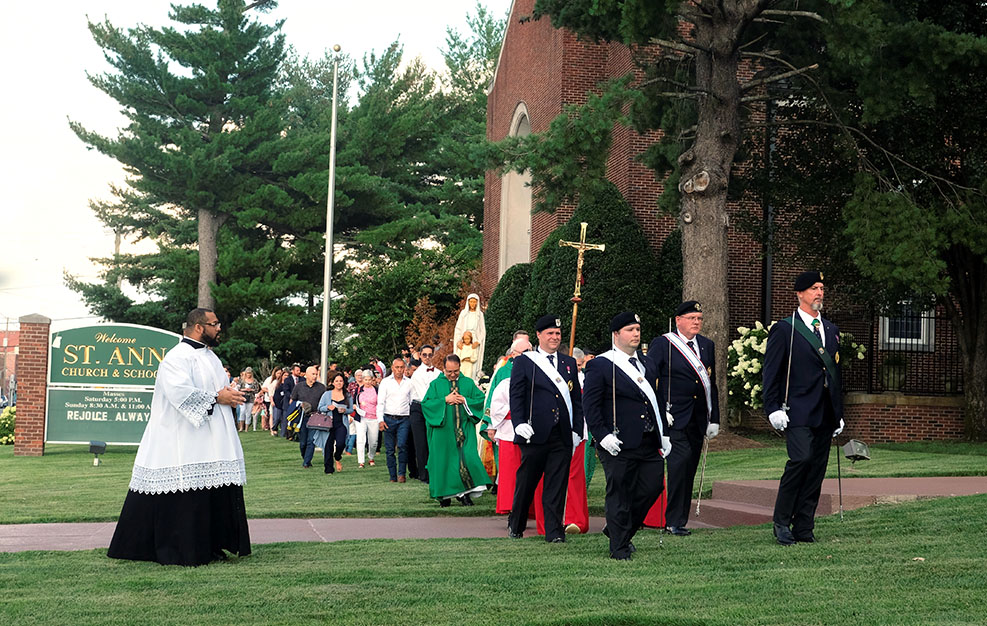
Anna Rumfola, principal of St. Ann School, leads a meeting with teachers before school begins on Monday, Aug. 7. The school has a growing Hispanic community. Photos by Katie Peterson
As the faculty of St. Ann School gathered on Tuesday, Aug. 1, for a meeting before the start of the new school year, they all donned new T-shirts that simply said, “Yo (amo) las escuelas Católicas” or “I (love) Catholic schools” with a Sacred Heart in the place of the word for love.
It was the perfect outward symbol of the work to come with the beginning of the year on Monday, Aug. 7, as St. Ann works tirelessly to bring belonging and empowerment to its growing Hispanic community.
This year, 15 percent of the school’s students include non-English speakers or students who consider English to be their second language, most of whom are Hispanic. It’s a jump from the less than 2 percent the previous school year.
“Every grade, from pre-kindergarten 3 through eighth grade, has at least one non-English speaker this year,” said Anna Rumfola, principal of St. Ann.
To better accommodate them, Rumfola said, the school has implemented several initiatives to better serve their needs. One was through the hiring of Gemma Martin as the Hispanic family coordinator.
Martin is a native of Madrid, Spain, who moved to Nashville three years ago, and was a substitute kindergarten teacher and helped with English as a Second Language instruction last school year at St. Ann.
She has a bachelor’s degree in psychology from Universidad Complutense in Madrid as well as a bachelor’s degree in elementary education from Universidad Internacional La Rioja. Martin has also had several years’ experience working in bilingual schools in Spain, as well as working for nonprofits.
“It’s about finding ways to be present to our Spanish-speaking families,” Rumfola said. “It’s about putting people in place like Gemma and some of our other Spanish-speaking parents who have for years expressed the interest in wanting to help, and then finally, my advancement team and I saying, ‘Yes, we need help here and this is an avenue we could definitely explore.’
“Having a Spanish-speaking person on staff has greatly helped in the fact that parents feel like there is someone they can talk to and ask questions, we are really working hard to help everyone know they belong,” she said.
Martin’s role will be to teach and assist Spanish-speaking families in any task that might come up, whether it’s helping with documentation and registration, school supplies, translating the school newsletter, working one-on-one with students who need a little more help, and more.
“Whatever they may need, they can reach out to me,” Martin said.
“I hope this gives all of our families more confidence and security in knowing that they can send their children to St. Ann,” Rumfola said. “I want them as parents to feel empowered that they can navigate a school system.
“We don’t have all the resources that (Metro Public Schools) have, but I don’t want them to ever think, ‘I can’t go there because I don’t speak English,’” she continued. “I don’t ever want it to be something where they feel like they don’t belong.”
Along with having Martin on campus full-time, St. Ann is also partnering with the University of Notre Dame as the staff take a one-year English as a New Language professional development program, so that all the teachers can learn ways to better serve their non-English speaking students and any of the students who are struggling in English.
“It’s giving the teachers another tool,” Rumfola said. “We all still have room to grow and we’re all still here to support each other.
“We feel comfortable as a faculty to grow together, to make mistakes, to laugh, and whenever you have that kind of support, then you grow professionally as well,” she said. “We’re going to all learn this together.”
There will also be a formal after-school Homework Club to help all students, too.
“It’s like anything in life,” Rumfola said. “If we’re comfortable where we’re learning, then we’re going to be stronger learners.”
The school is also making it a point to bring in some traditions familiar to the Hispanic community, whether it’s El Dia de Muertos on Nov. 1, The Feast of Our Lady of Guadalupe on Dec. 12, or Las Posadas around Christmas time.
“Our Spanish-speaking community has so much to offer to our students,” Rumfola said. “I would love to continue to see the growth in the classroom and having more students to where they feel like ‘This is my home.’”
“You’re gifting the learning of history, other traditions, other cultures to the whole school,” Martin added. “This is benefitting everybody; everybody enriches everybody, because we’re all one community.”
The growth of the Hispanic community is not limited to St. Ann School. St. Ann Church has also seen tremendous growth in the Hispanic community in recent years, reaching roughly 20 percent of the 800 registered families. Many of those families are the ones who are now calling St. Ann School home for their children.

Both the English-speaking and Spanish-speaking communities came together after the 5 p.m. Mass on Saturday, July 22, for a procession around the church campus with a statue of St. Ann before gathering for fellowship and a meal provided by the Hispanic community. The celebration was held in honor of the Feast of Sts. Joachim and Anne, the parents of the Blessed Virgin, celebrated on July 26.
“Food just brings people together,” Isabel Maxwell, member of the St. Ann hospitality committee, said of the event. “It was an opportunity to bring everyone together as one faith community.”
Father Michael Fye, pastor of St. Ann, said seeing the communities come together in faith was a great representation of the universality of the Church.
“When I was in Rome, I was surrounded by Christians and Catholics from all over the world, often people I had no connection with. The language, the culture, the situation, everything was so different,” Father Fye explained. “Yet, we were still attending Mass together, we were still praying together even in different languages, so the ability for the universal Catholic faith to bring people together was something I had personally experienced.
“In Nashville, Tennessee, we don’t have as many opportunities as Rome, Italy, to experience that, yet we don’t have to go very far to find people that live life a little differently,” he said. “Even in our own parish, we have people that speak different languages in their home, eat different food, even come from different backgrounds.
“Coming together to celebrate the same celebration, to eat food together, to get to know each other is a physical and visible manifestation of the universality of our faith.”









